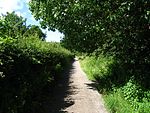West Kirby railway station
DfT Category E stationsFormer Wirral Railway stationsPages with no open date in Infobox stationRailway stations in Great Britain closed in 1896Railway stations in Great Britain opened in 1878 ... and 4 more
Railway stations in Great Britain opened in 1896Railway stations in the Metropolitan Borough of WirralRailway stations served by MerseyrailUse British English from February 2017

West Kirby railway station serves the town of West Kirby in Merseyside, England. The station is the terminus of the West Kirby branch line, which is one of the two branches of the Wirral Line on the Merseyrail network. There is a central island platform between two terminus tracks and two parallel sidings for out-of-use electric multiple units. A second station, which was the terminus of a branch line from Hooton, lay to the east of the Wirral Line station; it was closed in 1962.
Excerpt from the Wikipedia article West Kirby railway station (License: CC BY-SA 3.0, Authors, Images).West Kirby railway station
Wirral
Geographical coordinates (GPS) Address Nearby Places Show on map
Geographical coordinates (GPS)
| Latitude | Longitude |
|---|---|
| N 53.373 ° | E -3.184 ° |
Address
CH48 4DZ Wirral, Grange
England, United Kingdom
Open on Google Maps







